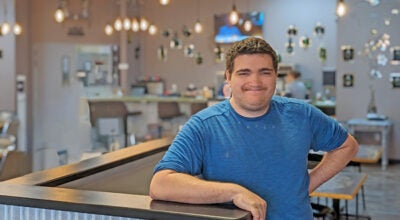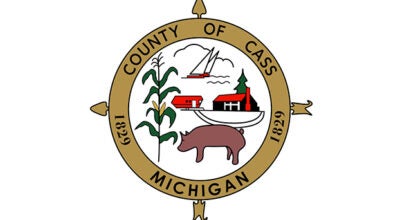An unrecognized but overwhelming need
Published 10:08 am Friday, December 4, 2009

Mike Cameron of the Kiwanis Club delivers boots to Northside Child Development Center's Kathy Emmons donated to those children in need at the school. The club is donating boots to Niles and Brandywine elementary schools. (Daily Star Photo/JESSICA SIEFF)
By JESSICA SIEFF
Niles Daily Star
They say one can tell a hungry child by the eyes. There’s a despondency, a lack of focus, a distance keeping children from their school work.
They say the signs of stress on a teenager show up in slipping grades. Absences. A struggle for focus. They’re working after school, or during school, they’re working to help out at home, they’re working to achieve a sense of stability and an education at the same time.
From elementary school to high school students, children – and their families – are having a tough time in Niles and their struggles do not go unseen. They’re being seen by teachers and guidance counselors inside the community’s schools.
It’s a struggle that goes beyond the classroom. And a battle teachers, parents and even outside organizations are fighting together. And it’s a fight without a clear resolution.
“We have children all the time that are in need of coats, boots, hats and gloves,” said Northside Child Development Center’s Kathy Emmons. Northside serves children in preschool and kindergarten. Children who Emmons said, “don’t have the essentials of what they need.”
An “At-Risk” school, Emmons said Northside has seen an unsettling increase in families in need of help. Help getting their children winter coats and boots, help getting food on the table, help with where to turn.
It’s not unusual for teachers to develop good repertoires with the parents of their students, for those parents to come to teachers and ask how they can help improve or strengthen their child’s education.
But Emmons said with the rise in unemployment, the stressed economy, parents are struggling more than ever and with nowhere else to turn – they’re coming to teachers for help.
Some are hungry. Some are trying to make ends meet. Some are homeless.
“Homelessness is defined by the federal government as not having a stable home (environment),” Emmons said. “We have a huge number of homeless” at Northside, she explained. For example, children whose parents have had to move in with friends or relatives, bouncing from one place to another, all the while trying to hang on to some sense of normalcy by keeping their kids in school.
At Northside, Emmons works inside the Parent Room, where parents sit down to discuss any issues that might be going on with their students. It’s become sort of a symbol of a safe haven these days, as more and more parents are calling in and coming in looking for help.
“We’ve had four families come to us on their own for food,” Emmons said. “It’s just a very, very needy time in this building.”
“There’s just a lot of neediness right now in our community,” said Niles High School’s Jenny Freeze.
When it comes to high school students, evidence of struggle changes its face.
“I know we have a lot of families with parents who’ve lost jobs,” Freeze said. Evidence of students having trouble at home pop up in slipping grades.
In many cases, Freeze said, students are working – whether part of a work-study program or in an after-school job.
“A lot of our students are contributing members of their family,” she said.
Today’s student faces overwhelming demands. In addition, those elements that can make things hard at home – a loss of one parent’s income, worries over lack of or loss of health insurance, illness such as parents or children diagnosed with cancer. They’re also facing increasing demands at school, with education more important than ever before to their future, getting into college and how to afford it.
Across the nation, hunger has become an issue that is getting more and more attention. Recently a poll of teachers across the country by the organization Share Our Strength, which works to end child hunger in America, found that more than half of the nation’s teachers not only see hunger in their students but are paying out of their own pockets to provide food for students.
Something Emmons said has happened at Northside as well.
“I don’t think that the majority of people in the community know how much people are struggling,” Emmons said.
At the high school a different problem – social stigma. Free and reduced breakfasts and lunches might be the only hot meal a student gets all day, Freeze said. But some might not take advantage of what’s offered, feeling self-conscious about doing so. School administrators and teachers work together as a team, she said, making sure there is an open line of communication between students, school officials and parents so they can do what they can to help and encourage students to sign up.
Freeze said students are also becoming more active in helping their fellow peers, conducting food and clothing drives to donate to the community.
Outside organizations are beginning to see the need as well.
Recently, Niles area credit unions came together to donate winter coats to area schools.
The Kiwanis Club of Niles is also helping out. As Emmons talked about the overwhelming situation at Northside, Mike Cameron of the Kiwanis Club sat and listened quietly. It was the need she speaks of that drove the club to come up with something to help. They have been donating 10 to 12 pairs of boots to Niles and Brandywine elementary schools.
But, Cameron said, it’s just a drop in the bucket.
Awareness, he added, is key.
“If people know what to do then typically they will find a way to help,” Cameron said.
At Northside, Emmons and her staff at the Parent Room try to do everything they can, from helping out with physical resources to giving parents direction to outside organizations that might be able to help. They also facilitate different training programs for parents, many of whom, she said are either young or single parents or more and more so parents out of work.
For Cameron’s part, he hopes more people will recognize the need that is spilling over in the area’s classrooms. The boots, he said, “doesn’t seem like a big solution … but it’s 12 kids who won’t be cold.”
Still, he added, “the need is much bigger than that.”






